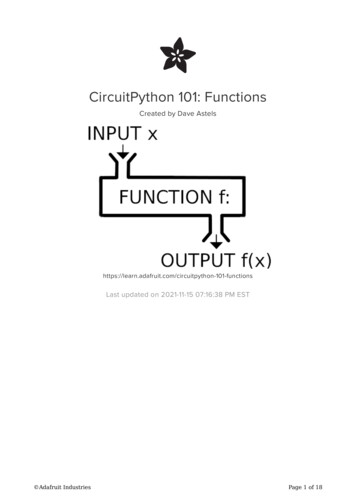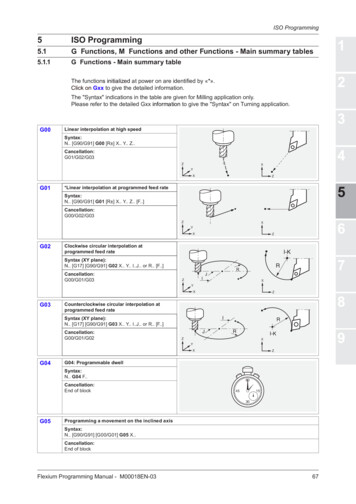
Transcription
CircuitPython 101: FunctionsCreated by Dave -functionsLast updated on 2021-11-15 07:16:38 PM EST Adafruit IndustriesPage 1 of 18
Table of ContentsOverview3Function Basics4 Guard ClausesPreconditionsReturning a ResultMultiple Return ValuesDefining FunctionsDefault ArgumentsKeyword Arguments5667789Functions as Data10 What def really doesCreating a function within a functionReturning functionsFunctions as Arguments10111213The Function With No Name14 Something Hardware Related16 Adafruit IndustriesPage 2 of 18
OverviewThis guide is part of a series on some of the more advanced features of Python, andspecifically CircuitPython. Are you new to using CircuitPython? No worries, there is afull getting started guide here (https://adafru.it/cpy-welcome).Adafruit suggests using the Mu editor to edit your code and have an interactive REPLin CircuitPython. You can learn about Mu and its installation in this tutorial (https://adafru.it/ANO).If you've been introduced to Python through CircuitPython, you might not have writtenmany functions yet. With the ATSAMD51 series of boards with its Cortex-M4 corewhat you can do with CircuitPython expands greatly. That means you can write larger,more complex programs that do more complex and interesting things. That complexitycan quickly get out of hand. Functions are a tool to help manage that complexity.Functions let you package up blocks of code to help make your programs morereusable, shareable, modular, and understandable.This guide will go over the basics of using functions in CircuitPython. Adafruit IndustriesPage 3 of 18
Function BasicsSimply put, functions are a block a code that is packaged up so as to be executedindependently, how and when you choose.Functions have parameters, and you provide arguments when you execute thefunction. That's generally referred to as calling the function, and the code that calls itis referred to as the caller.The idea of functions in programming goes all the way back to early assemblylanguages and the concept of the subroutine. Most assembly languages have a CALLoperation used to transfer control to the subroutine, and a RET operation to returncontrol back to the calling code. The BASIC language also used the term subroutineand had a GOSUB statement that was used to call them, and a RETURN statement.Most modern languages have dropped the explicit CALL or GOSUB statement infavor of implicit syntax to indicate a function call:function name(arg1, arg2, ., argn) Adafruit IndustriesPage 4 of 18
In assembly and BASIC, a subroutine had to end with an explicit RET or RETURN .Python loosens that up somewhat. If there is no value that needs to be sent back asthe result of the function, the return can be left implicit, as in the following:def foo(x):print("X is {}".format(x))>>> foo(5)x is 5We can use an explicit return, but it gains nothing and takes an additional line ofcode.def foo(x):print("X is {}".format(x))returnThere are two cases in Python where we do need to make the return explicit.1. When you need to return from the function before it naturally reaches the end.2. There is a value (or values) that needs to be sent back to the caller.Guard ClausesBelow is a trivial example of the first case.def foo(x):if x > 5:returnprint("X is {}".format(x))>>> foo(4)X is 4>>> foo(10)Using an if/return combination like this is often referred to as a guard clause. Theidea being that it gaurds entry into the body of the function much like security at anairport: you have to get past inspection before being allowed in. If you fail any of thechecks, you get tossed out immediately. Adafruit IndustriesPage 5 of 18
PreconditionsThis is also something called a precondition, although that usually implies a strongerresponse than simply returning early. Raising an exception, for example. You use aprecondition when the "bad" argument value should never be sent into the function,indicating a programming error somewhere. This can be done using assert insteadof the if/return . This will raise an AssertionError if the condition results in False .def foo(x):assert x < 5, "x can not be greater than 5"print("X is {}".format(x))>>> foo(10)Traceback (most recent call last):File "", line 1, inFile "", line 2, in fooAssertionError: x can not be greater than 5Since preconditions are meant to catch programming errors, they should only everraise an exception while you are working on the code. By the time it's finished, youshould have fixed all the problems. Preconditions provide a nice way of helping makesure you have.Although assert is supported, it's a little different in the context of CircuitPython.Your running project likely does not have a terminal connected. This means that youhave no way to see that an assert triggered, or why. The CircuitPython runtime getsaround this for runtime errors by flashing out a code on the onboard NeoPixel/DotStar. This lets you know there's a problem and you can connect to the board andsee the error output. But as I said, by the time you get to that point, there should beno programming errors remaining to cause unexpected exceptions.That's the key difference between things like guards and preconditions: your codeshould check for, and deal with, problems that legitimately could happen; things thatcould be expected. There's no way to handle situations that should never happen;they indicate that somewhere there's some incorrect code. All you can do is figure outwhat's wrong and fix it.Returning a ResultThe second case of requiring a return statement is when the function has to returna value to the caller. For example: Adafruit IndustriesPage 6 of 18
def the answer():return 42So what if you have a function that is expected to return a value and you want to usea guard? There is no universal answer to this, but there is often some value that canbe used to indicate that it wasn't appropriate to execute the function.For example, if a function returns a natural number (a positive integer, and sometimeszero depending on which definition you use), you could return a -1 to indicate that aguard caused an early return. A better solution is to return some sort of default value,maybe 0. This, also, is very situation dependant.Multiple Return ValuesNot only can functions return a value, they can return more than one. This is done bylisting the values after the return keyword, separated by commas.def double and square(x):return x x, x*xA function that returns multiple values actually returns a tuple containing thosevalues:>>> double and square(5)(10, 25)>>> type(double and square(5))<class 'tuple'>You can then use Python's parallel assignment to extract the values from the tupleinto separate variables.>>> d, s double and square(5)>>> d10>>> s25Defining FunctionsAs you can gather from the examples above, you use the def keyword to define afunction. The general form is: Adafruit IndustriesPage 7 of 18
def function name (parameter name 1, ., parameter name n):statement.statementYou can then call the function by using the name and providing arguments:function name(argument 1, ., argument n)This much we can see in the examples. Note that a function doesn't requireparameters and arguments If it does have some, those names are available inside thefunction, but not beyond it. We say that the scope of the parameters is the body of thefunction. The scope of a name is the part of the program where it is usable.If you use a name outside of its scope, CircuitPython will raise a NameError .>>> fooTraceback (most recent call last):File "", line 1, inNameError: name 'foo' is not definedChoosing good names for your functions is very important. They should conciselycommunicate to someone reading your code exactly what the function does. There'san old programmer joke that the person trying to read and understand your code willquite likely be you in a couple months. This becomes even more crucial if you shareyour code and others will be reading it.You don't want to name a function the same name as a Python command, thename of a library function, or any other name that might be confusing to othersreading your code.Default ArgumentsWhen a function is called, it must be provided with an argument for each parameter.This is generally done as part of the function call, but Python provides a way tospecify default arguments: follow the parameter name by an equals and the value tobe used if the function call doesn't provide one.def foo(x, msg ''):print("X is {}. {}".format(x, msg))>>> foo(5, 'hi')X is 5. hi Adafruit IndustriesPage 8 of 18
>>> foo(5)X is 5.We can see that if we provide an argument for the msg parameter, that is the valuethat will be used. If we don't provide an argument for it, the default value specifiedwhen the function was defined will be used.Keyword ArgumentsSo far the examples have been using what's called positional arguments. That justmeans that arguments are matched to parameters by their positions: the firstargument is used as the value of the first parameter, the second argument is used asthe value of the second parameter, and so on. This is the standard and is used bypretty much every language that uses this style of function definition/call.Python provides something else: keword arguments (sometimes called namedarguments). These let you associate an argument with a specific parameter,regardless of it's position in the argument list. You name an argument by prefixing theparameter name and an equals sign. Using the previous function foo :>>> foo(5, msg "hi")X is 5. hi>>> foo(msg 'hi', x 5)X is 5. hiNotice that by naming arguments their order can be changed. This can be useful todraw attention to arguments that are usually later in the list. There's one limitation:any (and all) positional arguments have to be before any keyword arguments:>>> foo(msg 'hi', 5)File "", line 1SyntaxError: positional argument follows keyword argumentEven without changing the order of arguments, keywords arguments lets us skiparguments that have default values and only provides the ones that are meaningfulfor the call. Finally, keyword arguments put labels on the arguments, and if theparameters are well named it's like attaching documentation to the arguments. TreyHunner has a great write-up on the topic (https://adafru.it/C2m). To pull an examplefrom there, consider this call:GzipFile(None, 'wt', 9, output file) Adafruit IndustriesPage 9 of 18
What's all this? It's dealing with a file so 'wt' is probably the mode (write andtruncate). The output file argument is clearly the file to write to, assuming it'sbeen well named. Even then, it could be a string containing the name of the outputfile. None and 9 , however, are pretty vague. Much clearer is a version usingkeyword arguments:GzipFile(fileobj output file, mode 'wt', compresslevel 9)Here it's clear that output file is the file object, and not the name. 'wt' is,indeed, the mode. And 9 is the compression level.This is also a prime example of the problems using numeric constant. What iscompression level 9? Is it 9/9, 9/10, or 9/100? Making things like this named constantsremoves a lot of ambiguity and misdirection.Functions as DataWhat def really doesdef function name (parameter name 1, ., parameter name n):statement.statementThe def keyword takes the body of the function definition (everything indentedbeneath the line starting with def) and packages it into a function object that can beevaluated later. It then associates that function object with the function name youprovided. It also takes the list of parameter names along with any default values andstores them in the function object.>>> def the answer():. return 42.>>> the answer()42>>> the answer<function>>>> f the answer>>> f()42Notice that if we type the name of the function rather than a call to the function atthe REPL prompt, the system tells us that it is a function . Furthermore, notice that Adafruit IndustriesPage 10 of 18
we can assign the value of a function (not it's result) to a variable, then use that to callthe function.Creating a function within a functionRemember when we talked about scope: the part of the code in which a name isknown and has a value? It so happens that the body of a function is a scope. Thingslike the function's parameters live in that scope. So do local variables you create (inPython you create local variables simply by assigning a value to a name within thescope). So do functions you define in that scope. Yes, you can create functions thatare local to a function.Here is a function to find square roots. It uses several helper functions. Since thesehelper functions are specific to the sqrt function, we define them inside it.def sqrt(x):def square(a):return a * adef good enough(g):return abs(square(g) - x) < 0.001def average(a, b):return (a b) / 2def improve(g):return average(g, x / g)guess 1.0while not good enough(guess):guess improve(guess)return guessIf you take a minute to understand this code, you might think "Why can't you just writeit like this:"def sqrt(x):guess 1.0while abs(guess * guess - x) > 0.001:guess (guess x / guess) / 2return guessYou could. It works the same. And if you were constrained for space, like on aSAMD21, it could be worth the denser code. But this series is about things you can doon the SAMD51 MCU. You have room to write nicer, cleaner, better code. The firstversion is easier to read, understand, and tweak as required. That's worth somespace, if you can afford it. The first version is simply the second decomposed into Adafruit IndustriesPage 11 of 18
meaningful chunks and given names that explain what each one does. Because theyare defined inside the sqrt function, they don't pollute the namespace with singleuse functions.Returning functionsFunctions in Python are first class data. One thing that means is that they can becreated in another function and returned. That's pretty cool. As an example, considerthe following:def make adder(x):def adder(a):return a xreturn adderThe function make adder defines and returns a function that has one parameter andreturns the sum of it's argument and the argument to make adder when the returnedfunction was defined. Whew! Now we can try it out.>>> inc make adder(1)>>> inc<closure>>>> inc(3)4>>> inc(5)6That's interesting. The type of the returned function isn't function , it's closure . Aclosure is the combination of a function and the scope in which it was defined. In thisexample, the returned function refers to its creator function's parameter x . When thefunction is executed later (and is a different scope) it still has a hold of the value thatx had when it was created: 1 in this case.We can save the returned closure in a variable (we called it inc ) and call it later justlike a regularly defined function. Given the above we can now gt;4dec make adder(-1)dec(1)dec(5)inc(3) Adafruit IndustriesPage 12 of 18
The dec function is totally separate from inc , which continues to work as before.Each time a new function is created and returned by make adder it has a differentcopy of the scope, and so its own value for x .Functions as ArgumentsLet's reconsider the square root function:def sqrt(x):def square(a):return a * adef good enough(g):return abs(square(g) - x) < 0.001def average(a, b):return (a b) / 2def improve(g):return average(g, x / g)guess 1.0while not good enough(guess):guess improve(guess)return guessAt the core of this is a general algorithm for finding a solution:while not good enough(guess):guess improve(guess)In English this is "While your guess isn't good enough, make a better guess."The algorithm doesn't really care what good enough and improve mean. Becausefunctions in Python are first class data, they can not only be returned, but also usedas arguments. So we can write a general solver:def solver(good enough, improve, initial guess):def solve(x):guess initial guesswhile not good enough(x, guess):guess improve(x, guess)return guessreturn solveNow we can use this to create a square root solver given the two functions and aninitial guess: Adafruit IndustriesPage 13 of 18
def sqrt good enough(x, guess):def square(a):return a * areturn abs(square(guess) - x) < 0.001def sqrt improve(x, guess):def average(a, b):return (a b) / 2return average(guess, x / guess)Putting it all together:sqrt solver(sqrt good enough, sqrt improve, 1.0)>>> sqrt(25)5.00002The Function With No NameNotice that since we've pulled the good enough and improve functions out, they'renot hidden out of sight any more. Python has another capability that we can use toaddress this: lambdas.Lambdas are another great thing that comes from the language Lisp. A lambda isessentially an anonymous function: a function object with no name. You might say"Then how do you use it if you can't get to it by using it's name?" That's a valid point,except that lambdas are meant to be throw away functions: used once and discardedso there's seldom a reason to hold onto them. Combine this with the ability to passfunctions into other functions and be returned by them, and we have some pretty coolabilities. Adafruit IndustriesPage 14 of 18
The syntax to create a lambda is fairly simple:lambda parameter 1, ., parameter n : expressionThe one limitation of lambdas in Python is that they can contain just a singleexpression that gets implicitly returned. That's not usually a problem, since it's allthat's typically needed.Let's revisit that last example.def sqrt good enough(x, guess):def square(a):return a * areturn abs(square(guess) - x) < 0.001def sqrt improve(x, guess):def average(a, b):return (a b) / 2return average(guess, x / guess)We will start by inlining the square and average functions.def sqrt good enough(x, guess):return abs(guess * guess - x) < 0.001def sqrt improve(x, guess):return average((guess x / guess) / 2)So now each of these is the return of a single expression. They can easily be replacedby lambdas:sqrt good enough lambda x, guess: abs(guess * guess - x) < 0.001sqrt improve lambda x, guess: (guess x / guess) / 2This creates two lambdas and assigns them to variables that have the name we usedfor the original functions. Now we can do the same as we did before:sqrt solver(sqrt good enough, sqrt improve, 1.0)>>> sqrt(25)5.00002However, we can do one better. If we don't need to save these lambdas (and as I said,we seldom do), we can just create them and pass them directly into solver :sqrt solver(lambda x, guess: abs(guess * guess - x) < 0.001,lambda x, guess: (guess x / guess) / 2,1.0) Adafruit IndustriesPage 15 of 18
>>> sqrt(25)5.00002In a similar vein, the make adder function from before can be drastically simplifiedby returning a lambda:def make adder(x):return lambda a: a xSomething Hardware RelatedThis example is from a project for an upcoming guide (at the time of writing this) sonot all the code is finished or available. But enough around this example is to be agood demo.The project uses a Crickit and makes heavy use of digital IO. How many still isn'tcertain, but it will be more than the Crickit or the MCU board provides by themselves.That means some Crickit IO will be used as well as some on-board IO. These will beprimarily driven by mechanical switches which will need to be debounced.I ported a debouncer class to CircuitPython for a previous project (https://adafru.it/BIT) that worked directly against an on-board digital input. That wouldn't work for thenew project since dealing with the two input sources is done differently. The solutionwas to generalize the debouncer to work with a boolean function instead of a pin.Here's the two relevant methods (we'll have a deep dive into CircuitPython's objectoriented features in a later guide):class Debouncer(object):.def init (self, f, interval 0.010):"""Make an instance.:param function f: the function whose return value is to be debounced:param int interval: bounce threshold in seconds (default is 0.010, i.e.10 milliseconds)"""self.state 0x00self.f fif f():self. set state(Debouncer.DEBOUNCED STATE Debouncer.UNSTABLE STATE)self.previous time 0if interval is None:self.interval 0.010else:self.interval interval.def update(self):"""Update the debouncer state. Must be called before using any of the Adafruit IndustriesPage 16 of 18
properties below"""now time.monotonic()self. unset state(Debouncer.CHANGED STATE)current state self.f()if current state ! self. get state(Debouncer.UNSTABLE STATE):self.previous time nowself. toggle state(Debouncer.UNSTABLE STATE)else:if now - self.previous time > self.interval:if current state ! self. get state(Debouncer.DEBOUNCED STATE):self.previous time nowself. toggle state(Debouncer.DEBOUNCED STATE)self. set state(Debouncer.CHANGED STATE)The relevant thing is the instance variable f . It's a function that gets passed in to theDebouncer constructor and saved. In the update function/method it's used to get a boolean value that is what's being debounced. The function f is simply somefunction that has no parameters and returns a boolean value. In the main projectcode some debouncers get created. Let's have a look at what those functions are thatare being passed to the debouncers.def make onboard input debouncer(pin):onboard input DigitalInOut(pin)onboard input.direction Direction.INPUTonboard input.pull Pull.UPreturn Debouncer(lambda : onboard input.value)def make criket signal debouncer(pin):ss input DigitalIO(ss, pin)ss input.switch to input(pull Pull.UP)return Debouncer(lambda : ss input.value)Here we have two functions: one to create a debouncer on an on-board digital pin,and one to create a debouncer on a crickit (aka Seesaw) digital pin. The setup of thepin's direction and pullup is a bit different in each case. Each of these sets up the pinas appropriate and creates (and returns) a debouncer using a lambda that fetches thepin's value. This is an example of a closure as well: the pin that the lambda fetchesthe value of is part of the scope (of the respective make * debouncer function) thatgoes along with the lambda. As far as the debouncer is concerned, it's a function thatreturns a boolean ; it neither knows or cares how what the function does beyondthat. It could be applied to any noisy boolean function, for example reading the Zvalue from an accelerometer to determine whether a robot is level. A Z value greaterthan 9 m/s2 would be a good indicator of that*. As the robot moves about, that valuewon't be steady. Debouncing would clean it up and answer the question "is the robotlevel" as opposed to "is the robot level at the instant the accelerometer was read".Assuming sensor is an accelerometer interface object that is in scope, the code tocreate that debouncer would be something like ():robot level Debouncer(lambda : sensor.accelerometer[2] > 9.0) Adafruit IndustriesPage 17 of 18
*Assuming the robots is on the surface of the Earth where the gravitational constant it 9.8 m/s2. Adafruit IndustriesPage 18 of 18
Nov 15, 2021 · Python provides something else: keword arguments (sometimes called named arguments). These let you associate an argument with a specific parameter, regardless of it's position in the argument list. You name an argument by prefixing the parameter name and an equals sign. Using the previous function






